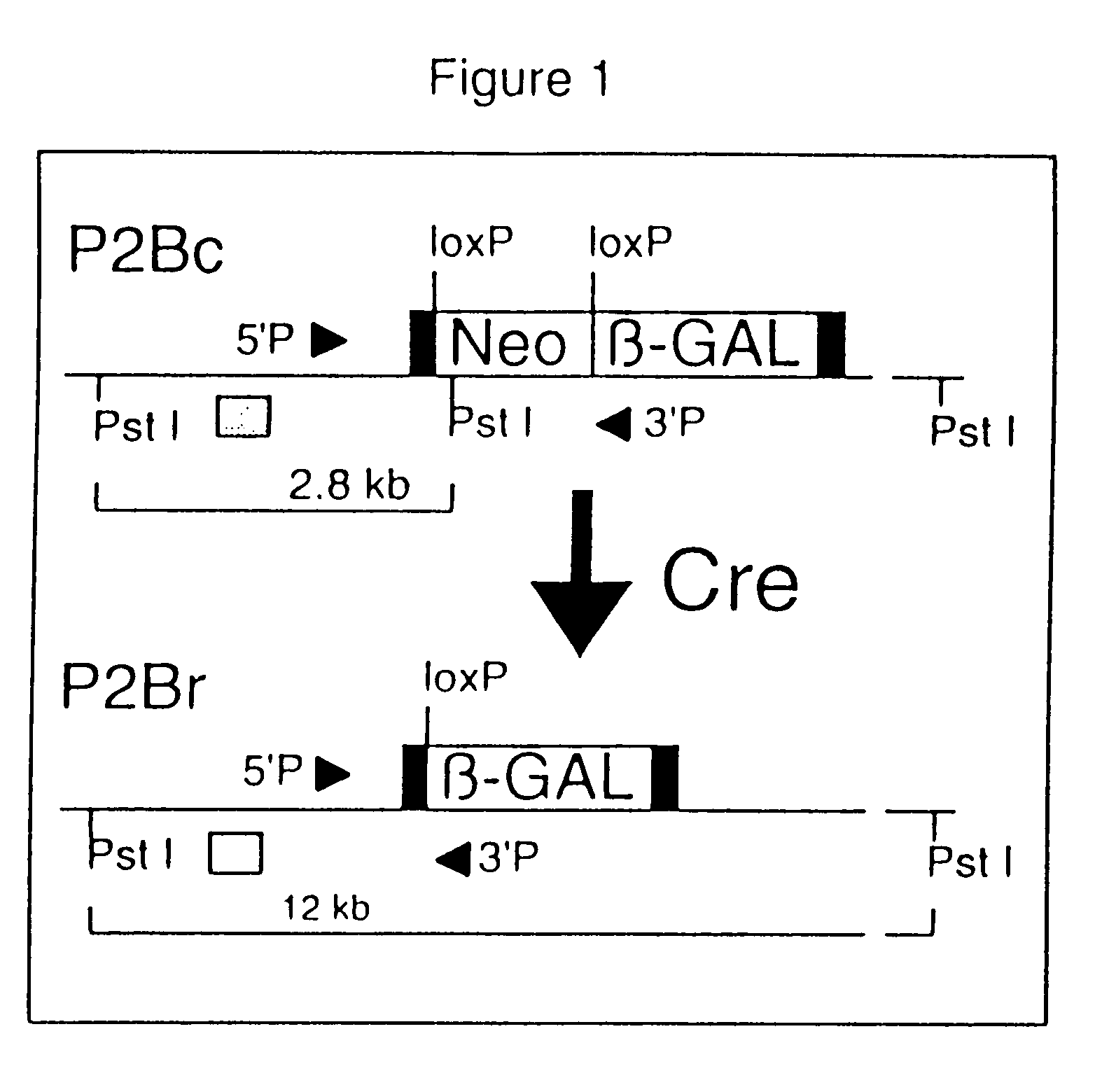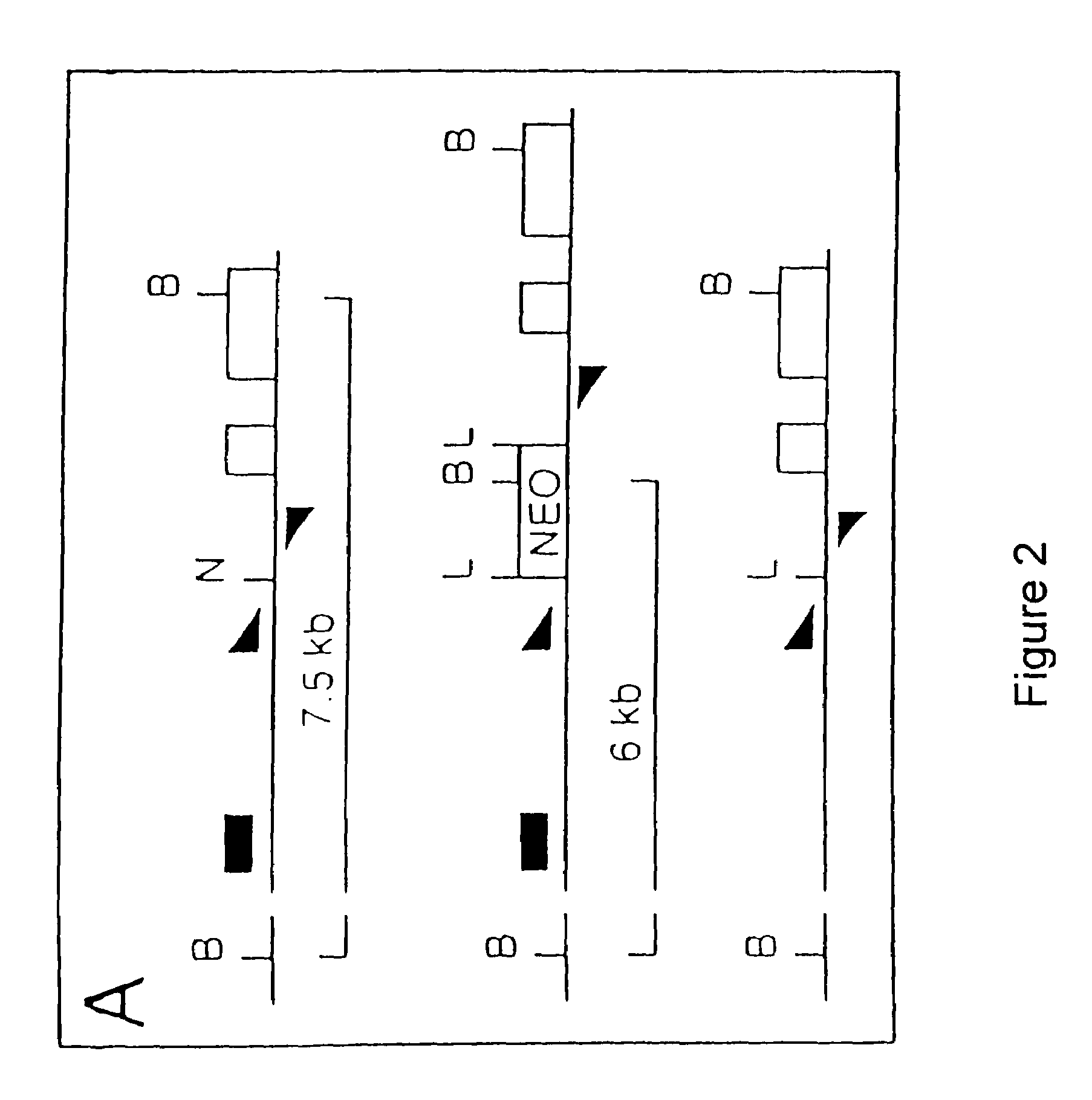Site-specific recombination in eukaryotes and constructs useful therefor
a recombination and construct technology, applied in the field of site-specific recombination in eukaryotes and constructs useful therefor, can solve the problems of reducing the potential of germline entry, unable to translate at detectable, and inclusion of the mp1 promoter
- Summary
- Abstract
- Description
- Claims
- Application Information
AI Technical Summary
Benefits of technology
Problems solved by technology
Method used
Image
Examples
example 1
Mammalian DNA Constructs
[0067]A 652 bp fragment of the mP1 promoter (SEQ ID NO:1; Peschon et al. (1989) Annals of the New York Academy of Sciences 186–197) was isolated by PCR using genomic DNA from CCE ES cells (Robertson et al. (1986) Nature 323:445–448) as a template. This fragment was fused to a Cre coding sequence modified to contain a consensus translation start site (Kozak (1986) Cell 44:283–292), 11 codons for a human c-myc epitope (Evan et al. (1985) Mol Cell Biol 5:3610–3616), 7 codons for a minimal SV40 nuclear localization signal (Kalderon et al. (1984) Cell 39:499–509) and the polyadenylation signal from pIC-Cre in the plasmid pOG304M (SEQ ID NO:4). The Cre expression plasmid pOG231 was prepared by fusing a Cre coding sequence modified from pIC-Cre (Gu et al. (1993) Cell 73:1155–1164), and containing the same translation start and nuclear localization signal, to the synthetic intron and CMV promoter of pOG44 (O'Gorman et al. (1991) Science 251:1351–1355).
[0068]A plasmid...
example 2
Production of Transgenic Mice
[0069]Fertilized oocytes obtained from matings of 129 / SvJae (Simpson et al. (1997) Nat Genet 16:19–27) and BALB / c×C57BL / 6 F1 mice were used for pronuclear injections of the Protamine-Cre fusion gene from pOG304M according to standard protocols (Hogan et al. Manipulating the Mouse Embryo: The Manual, Coldspring Harbor Press (1994), pg. 497). Production of ES cells and homologous recombinants: Heterozygous ProCre 129 / SvJae males were mated to 129 / SvEms−+Ter? / J females (Simpson et al. (1997) Nat Genet 16:19–27) to produce blastocysts that were cultured according to standard protocols (Robertson (1987) Teratocarcinomas and embryonic stem cells, a practical approach, eds. E. J. Robertson (IRL Press), pp. 71–112). The sex (King et al. (1994) Genomics 24:159–68) and ProCre status of each line were determined by PCR assays. Molecular analyses: Tail biopsy genomic DNA was used for hybridization assays or PCR assays to identify ProCre and P2Bc / r mice. PCR reaction...
example 3
ProCre Nucleic Acid Constructs Efficiently Recombine Target Alleles
[0070]A total of nine founder animals with ProCre nucleic acid constructs were obtained from injections of a Protamine-Cre fusion gene. Two lines were derived from injections of 129SvJae (Simpson et al. (1997) Nat Genet 16:19–27) embryos, and seven from injections of CB6F2 embryos. The 129 / SvJae lines and three randomly selected hybrid lines were examined in detail. To determine whether ProCre nucleic acid constructs would efficiently recombine a target allele, males were generated that contained a ProCre nucleic acid construct and a target for Cre-mediated recombination. This “P2Bc” (Pol II, β-GAL, conditional) target (FIG. 1) was created using homologous recombination in ES cells to insert a loxP-flanked neomycin cassette and a β-GAL coding sequence into the first exon of the locus coding for the large subunit of RNA polymerase II. Cre-mediated recombination of the loxP sites was expected to delete the intercalated...
PUM
| Property | Measurement | Unit |
|---|---|---|
| temperature | aaaaa | aaaaa |
| volume | aaaaa | aaaaa |
| time | aaaaa | aaaaa |
Abstract
Description
Claims
Application Information
 Login to View More
Login to View More - R&D
- Intellectual Property
- Life Sciences
- Materials
- Tech Scout
- Unparalleled Data Quality
- Higher Quality Content
- 60% Fewer Hallucinations
Browse by: Latest US Patents, China's latest patents, Technical Efficacy Thesaurus, Application Domain, Technology Topic, Popular Technical Reports.
© 2025 PatSnap. All rights reserved.Legal|Privacy policy|Modern Slavery Act Transparency Statement|Sitemap|About US| Contact US: help@patsnap.com


